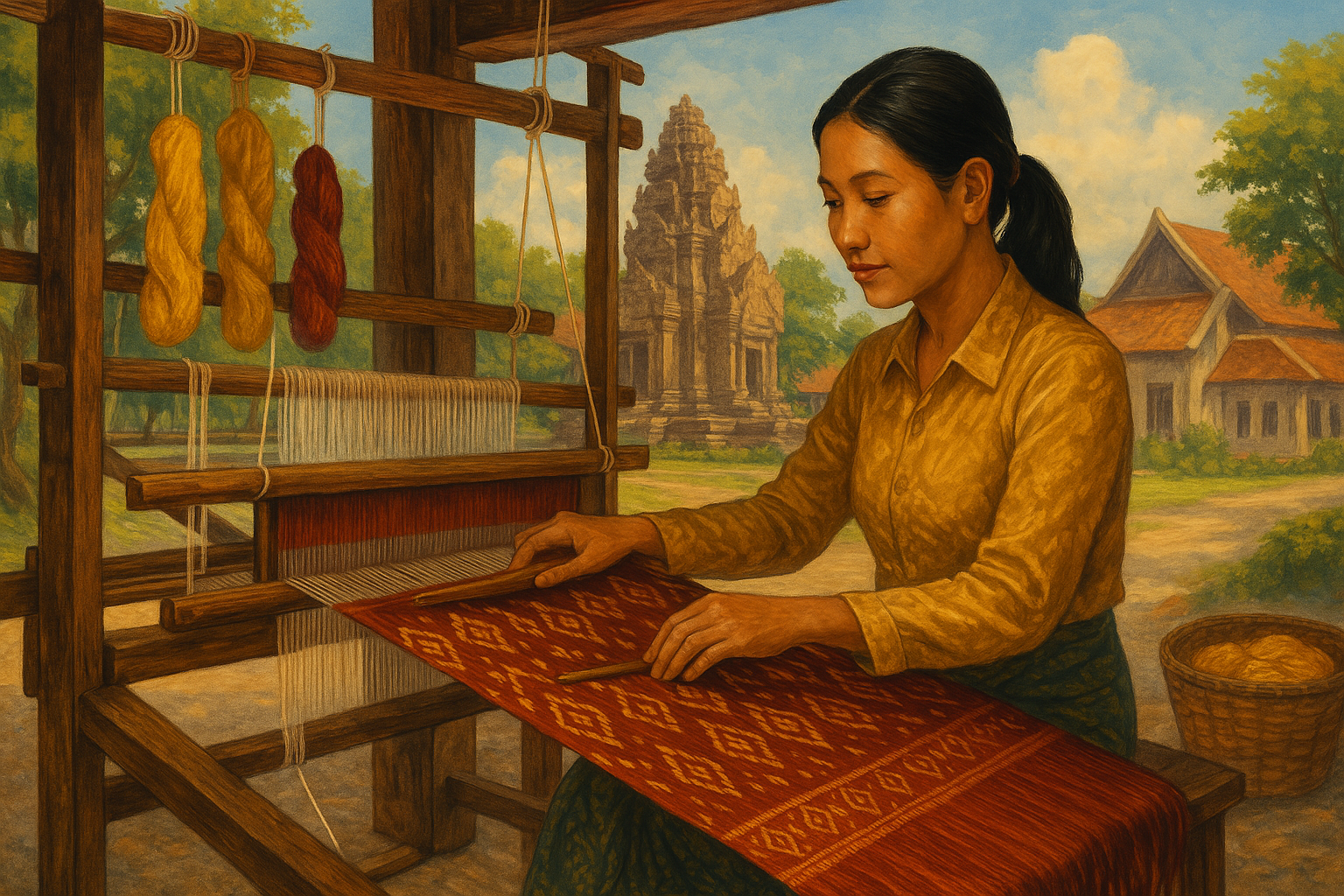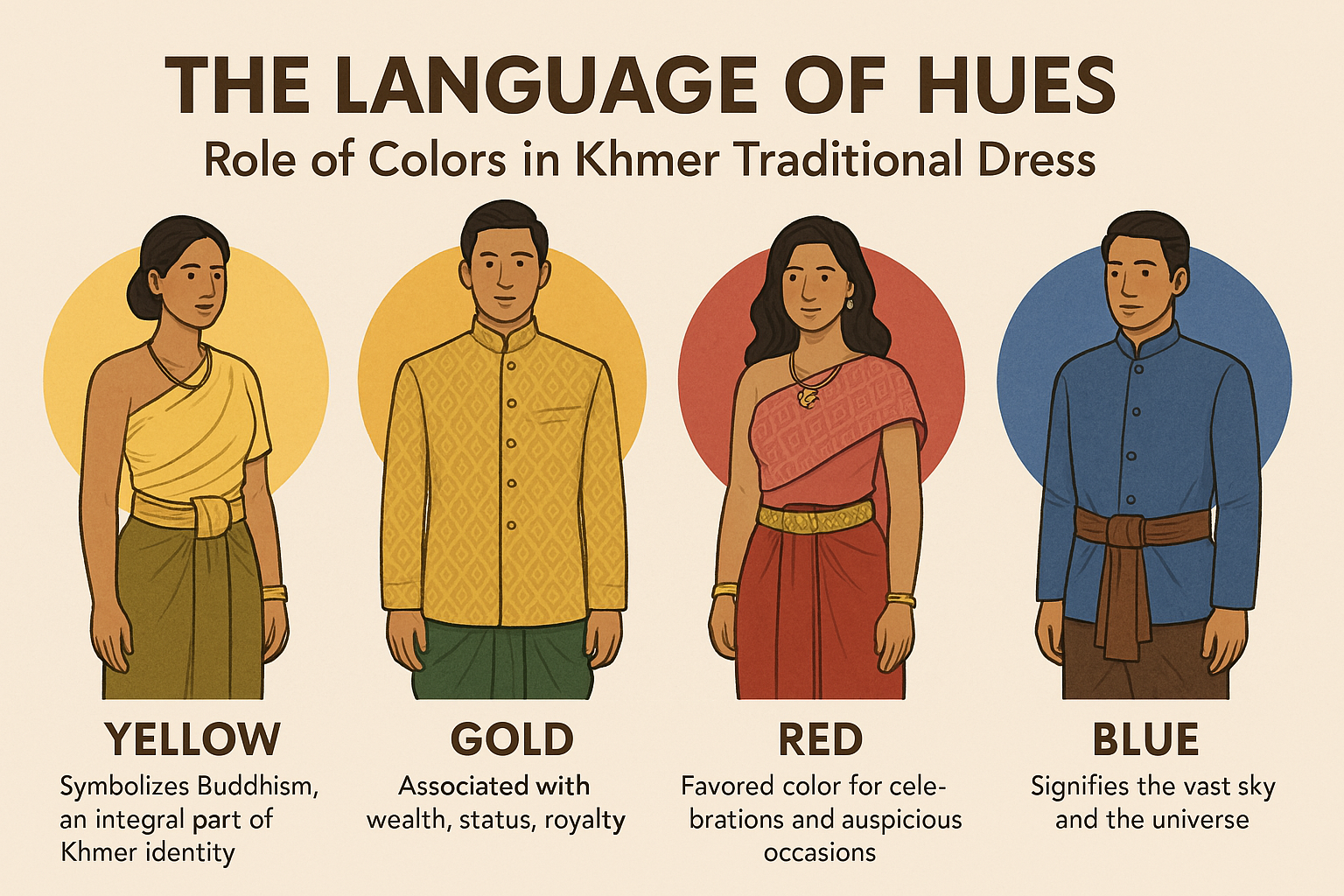While modern Western clothing is the norm for daily life across Cambodia today, traditional Khmer attire for men continues to hold significant cultural importance, reserved primarily for formal events, ceremonies, and expressions of national identity. Rooted in centuries of history and reflecting social hierarchy, these garments, particularly the distinctive Sampot Chang Kben, showcase Khmer elegance and tradition, often visible during weddings and festivals in provinces like Battambang.
The Distinguished Wrap: Sampot Chang Kben
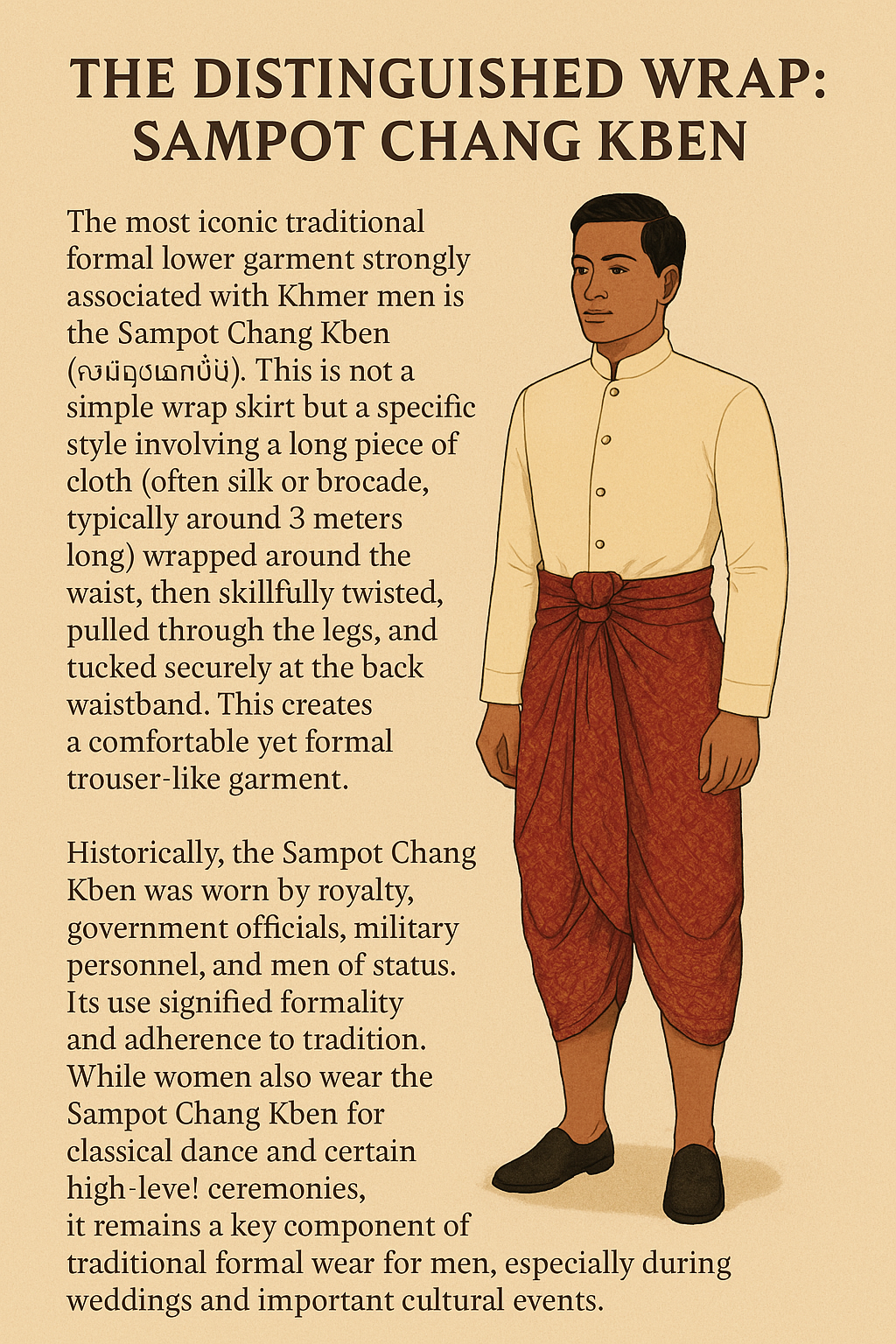
The most iconic traditional formal lower garment strongly associated with Khmer men is the Sampot Chang Kben (សំពត់ចងក្បិន). This is not a simple wrap skirt but a specific style involving a long piece of cloth (often silk or brocade, typically around 3 meters long) wrapped around the waist, then skillfully twisted, pulled through the legs, and tucked securely at the back waistband. This creates a comfortable yet formal trouser-like garment.
Historically, the Sampot Chang Kben was worn by royalty, government officials, military personnel, and men of status. Its use signified formality and adherence to tradition. While women also wear the Sampot Chang Kben for classical dance and certain high-level ceremonies, it remains a key component of traditional formal wear for men, especially during weddings and important cultural events.
Completing the Look: Shirts and Formal Jackets
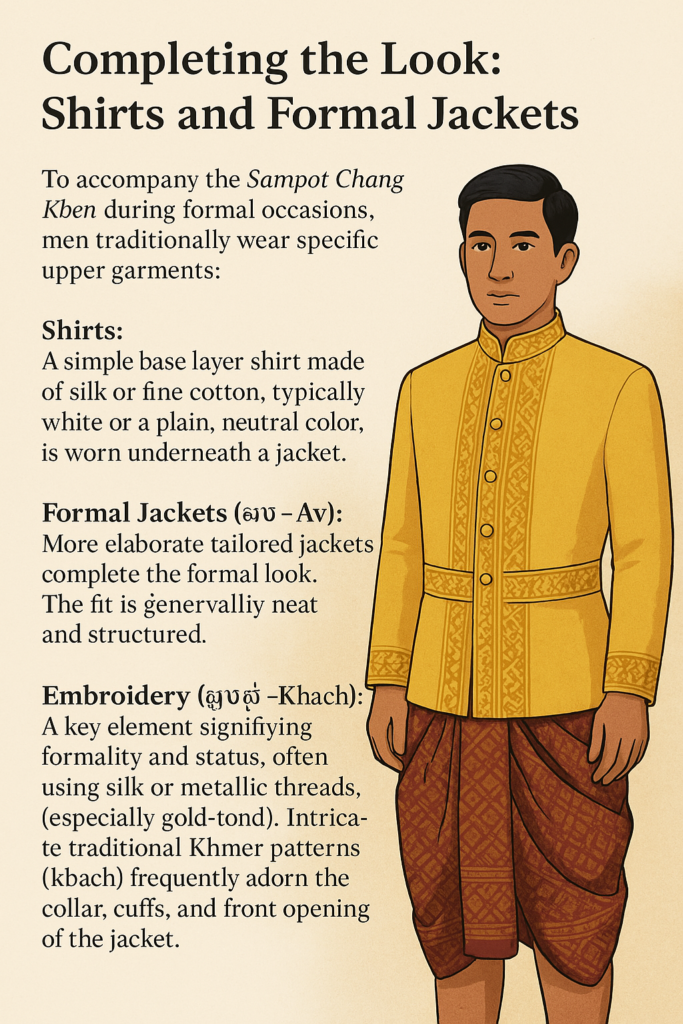
To accompany the Sampot Chang Kben during formal occasions, men traditionally wear specific upper garments:
- Shirts: Often, a simple base layer shirt made of silk or fine cotton, typically white or a plain, neutral color, is worn underneath a jacket.
- Formal Jackets (អាវ – Av): More elaborate tailored jackets complete the formal look. These can vary in style, sometimes featuring standing mandarin collars, specific button configurations, or cuts influenced by historical Khmer court attire. The fit is generally neat and structured.
- Embroidery (ក្បាច់ – Kbach): A key element signifying formality and status is decorative embroidery, often using silk or metallic threads (especially gold-toned). Intricate traditional Khmer patterns (kbach) frequently adorn the collar, cuffs, and front opening of the jacket.
Fabric and Form: Differences by Class and Region
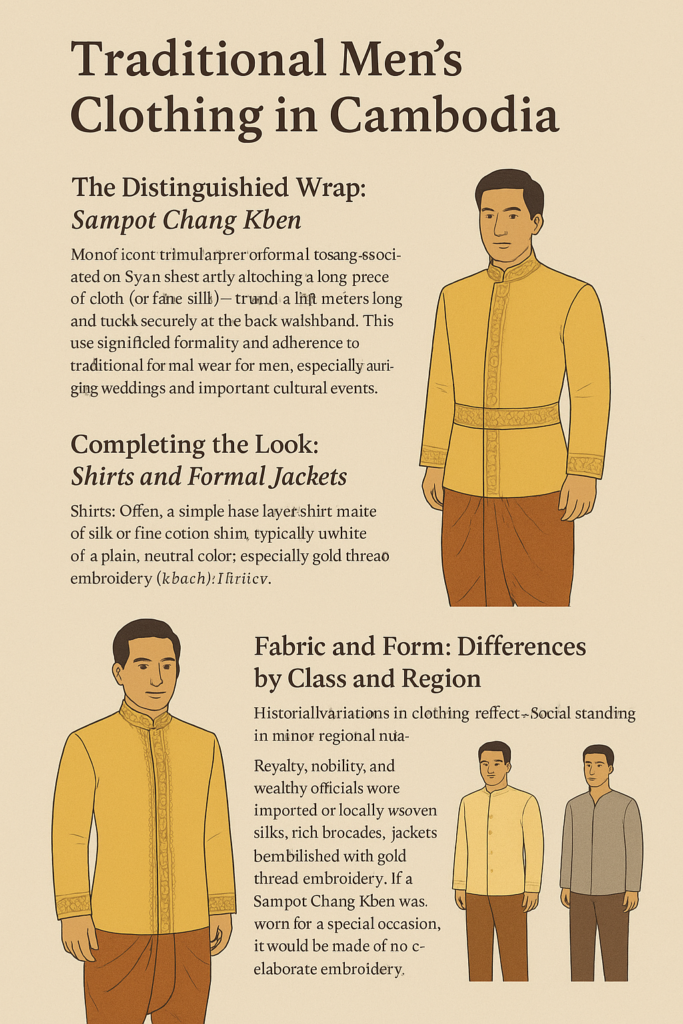
As with most traditional societies, clothing historically reflected social standing and sometimes regional nuances:
- Social Class: The quality of materials was a primary indicator of status. Royalty, nobility, and wealthy officials could afford the finest imported or locally woven silks, rich brocades, and jackets heavily embellished with gold thread embroidery. Common men, particularly in rural areas, typically wore simpler lower garments like cotton Sarongs (សារ៉ុង) for daily life and work. If a Sampot Chang Kben was worn for a special occasion, it would likely be made of less expensive cotton or basic silk, with minimal or no elaborate embroidery.
- Regional Differences: While the Sampot Chang Kben and formal jacket combination formed a relatively standard national style for formal wear, minor historical variations in jacket cuts, preferred local fabrics, or specific decorative motifs might have existed regionally. It’s also important to note that Cambodia’s diverse ethnic minority groups (such as the Cham, Kola, or various highland communities) possess their own distinct traditional clothing styles, different from ethnic Khmer attire.
Tradition Reimagined: Adaptation into Modern Fashion
Elements of traditional Khmer men’s attire continue to influence contemporary styles as of 2025:
- Ceremonial Continuity: The Sampot Chang Kben and formal jacket remain standard attire for grooms at traditional weddings and are worn by officials or participants during important national ceremonies, often using modern fabrics but retaining the classic silhouette.
- Fashion Inspiration: Cambodian fashion designers occasionally draw inspiration from traditional forms. This might manifest as modern trousers with a Chang Kben-style wrap detail, shirts featuring traditional kbach embroidery patterns, or jackets with cuts echoing historical styles.
- Casual Comfort: The simple cotton sarong endures as a comfortable and practical garment commonly worn by men informally at home.
Echoes Across Borders: Shared and Khmer Influences on Thai and Vietnamese Dress
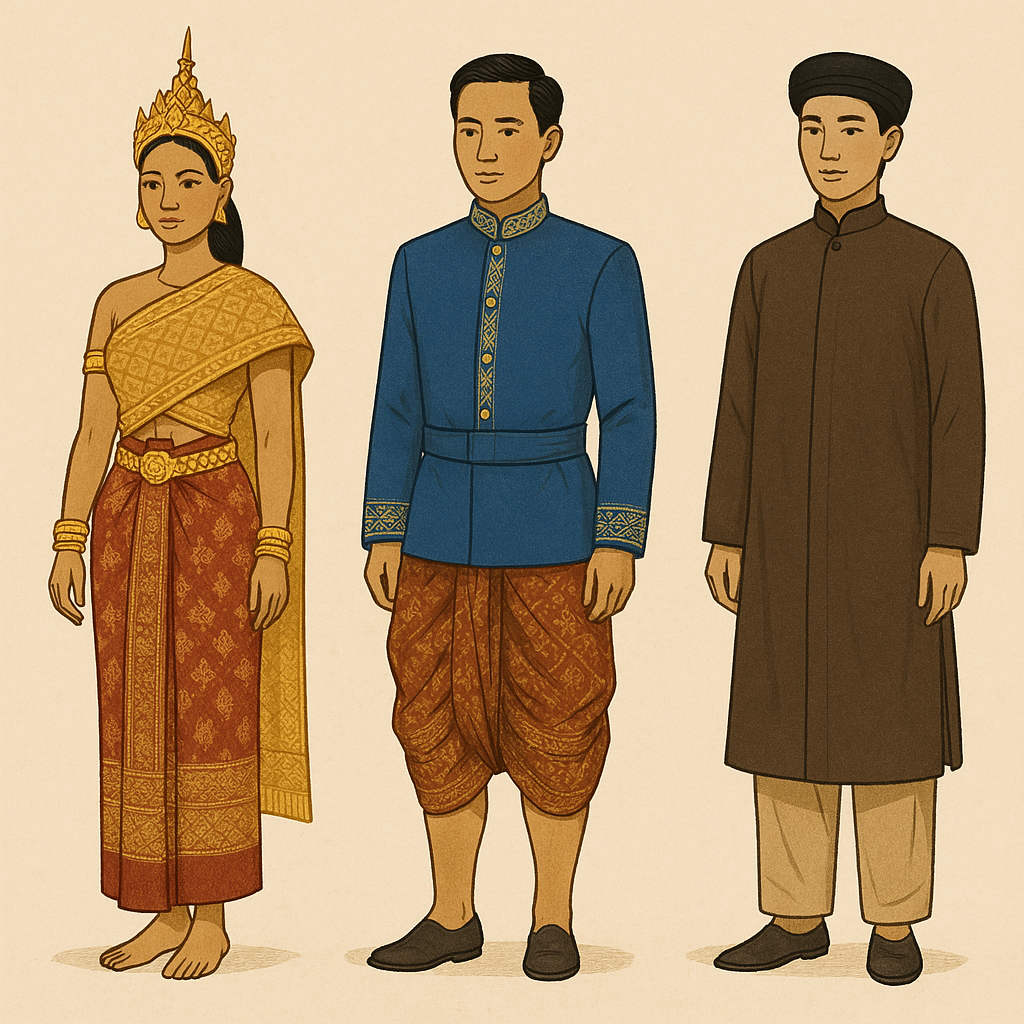
Cambodia’s geographic location and long history of regional interaction have shaped a rich tapestry of cultural exchange—not just in one direction, but across borders. While Khmer dress reflects some shared elements with Thai and Vietnamese attire, it’s equally important to recognize how Khmer styles have influenced its neighbors.
Thai Influence—and Khmer Influence on Thailand:
The Khmer Sampot Chang Kben and the Thai chong kraben bear striking resemblances, pointing to a deep-rooted exchange that likely dates back to the Angkorian era and continued through later interactions during the Ayutthaya and Rattanakosin periods. While these similarities are often viewed as Thai influences on Khmer dress, it is just as plausible that Khmer traditions shaped Thai court and everyday attire, particularly considering the prominence of the Angkorian Empire in Southeast Asia’s early history. Parallels in formal jacket styles also hint at centuries of mutual borrowing and refinement between Khmer and Thai courts.
Vietnamese Influence—and Khmer Echoes in Vietnam:
In border regions and during periods of Vietnamese political expansion, Khmer dress may have absorbed subtle stylistic traits—such as specific tunic shapes or collar designs. However, there’s little evidence of full-scale adoption of iconic Vietnamese garments like the áo dài within traditional Khmer male dress. Instead, Cambodian styles—especially in pre-colonial times—likely left their mark on neighboring Vietnamese communities, particularly among ethnic Khmer populations in the Mekong Delta.
Ultimately, the influence flowed both ways. Khmer clothing traditions were not only shaped by but also helped shape the broader sartorial landscape of mainland Southeast Asia.
Conclusion
Traditional Cambodian men’s clothing, epitomized by the formal elegance of the Sampot Chang Kben paired with an embellished jacket, represents a significant aspect of the nation’s cultural heritage. While largely replaced by Western styles for everyday wear, these traditional garments remain indispensable for marking important life events, ceremonies, and expressing national identity. Shaped by internal social structures and a history of regional interaction, this attire continues to be valued and visibly celebrated during special occasions in Battambang and throughout Cambodia today, connecting the present generation to their rich historical past. Sources and related content


